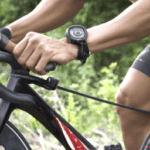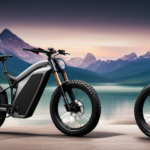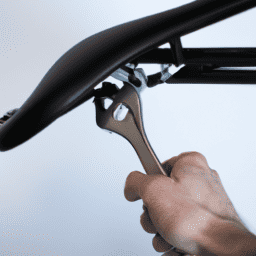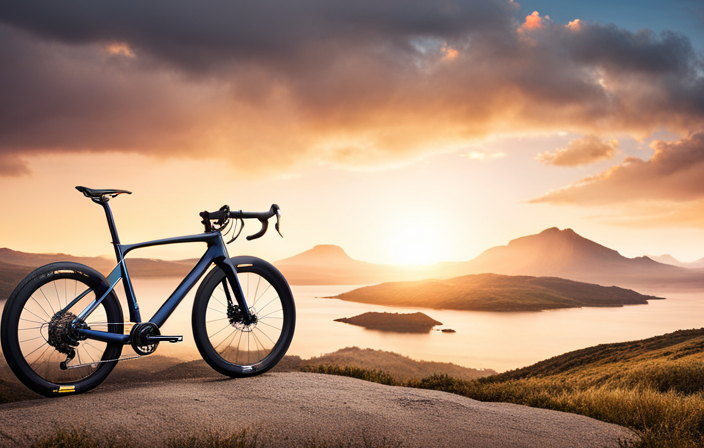As someone who cycles, I’ve consistently seen ascending hills as one of the more difficult parts of cycling on roads. The combination of sharp upward slopes and the need for significant physical effort to overcome them can be intimidating.
However, with the right technique and mindset, hill climbing can become a rewarding and satisfying part of your cycling experience.
In this article, I will share with you my tips and tricks for climbing hills on a road bicycle. From selecting the right gear to mastering your pedal stroke technique, I will provide you with the tools you need to tackle any hill with confidence and ease.
So, gear up and get ready to conquer those hills!
Key Takeaways
- Proper gear selection and pedal stroke technique are crucial for climbing hills efficiently and reducing fatigue.
- Mental preparation and persistence are key to improving hill climbing ability.
- Gradually increasing difficulty and distance, along with interval training, can improve overall fitness for hill climbing.
- Proper nutrition, hydration, pacing, and breathing techniques are important for sustained effort and preventing muscle fatigue during hill climbs.
Gear Selection
You gotta nail the gear selection if you want to conquer those hills like a boss! Hill climbing tips are essential to keep in mind when selecting the proper equipment for your ride.
It’s important to choose a gear that allows you to maintain a steady cadence, which means you must pick a gear that isn’t too easy or too hard. If the gear is too easy, you’ll spin out and lose speed; if it’s too hard, you’ll strain your legs and wear out quickly.
To make the right gear selection, try to anticipate the incline and adjust your gears accordingly. Once you find the right gear, stick with it and maintain a consistent pedal stroke. This will help you conserve energy and keep your momentum going.
Remember, proper gear selection is crucial for hill climbing, so take your time to find the right gear for each hill you encounter. With the right gear and a steady pedal stroke technique, you’ll be able to soar up those hills effortlessly.
Pedal Stroke Technique
To climb hills efficiently on a road bicycle, it’s important to have a good pedal stroke technique. Maintaining a steady cadence helps to conserve energy and reduce fatigue.
By focusing on efficiency, such as using the entire pedal stroke and avoiding unnecessary movements, you can optimize your power output and make hill climbing more manageable.
Maintain a Steady Cadence
As you approach the hill, feel the rhythm of your pedals like the beating of a drum, and let that steady cadence carry you up the climb. Maintaining a consistent cadence is key to conquering hills on a road bike.
A cadence of 70-90 revolutions per minute (rpm) is a good range to aim for, as it allows for efficient use of energy and helps prevent muscle fatigue. To maintain a steady cadence, it’s important to gear down before the climb and avoid shifting gears too frequently while ascending.
It’s also important to stay relaxed and use proper breathing techniques to conserve energy. Make sure to take deep breaths and exhale fully, allowing for maximum oxygen intake. Additionally, proper nutrition before and during the ride can help maintain energy levels and prevent cramping.
By focusing on maintaining a steady cadence and using proper breathing techniques and nutrition, you can efficiently climb hills on a road bike. As you ascend, remember to stay relaxed and focused on your technique, and soon you’ll be at the top of the hill with ease.
Focus on Efficiency
Get the most out of your ride by focusing on efficiency and maximizing your energy output. One way to do this is by focusing on breathing techniques. Proper breathing not only helps you maintain a steady rhythm and cadence, but it also helps to conserve energy. When climbing hills, it’s important to take deep breaths in through your nose and exhale slowly out of your mouth. This will help you to stay calm and relaxed, while also ensuring that your body is getting the oxygen it needs to keep going.
Another way to focus on efficiency is by paying attention to your body posture. When climbing hills, it’s important to keep your upper body still and relaxed, while also engaging your core muscles to help support your lower back. Additionally, you should try to keep your weight evenly distributed between your two pedals, and avoid any sudden movements or jerks that could throw you off balance. By focusing on your breathing techniques and body posture, you can climb hills more efficiently and with less strain on your body.
Body Position and Posture
Maintaining proper body position and posture on uphill climbs can greatly improve your efficiency and reduce fatigue, resulting in a 10-15% improvement in speed. When climbing, it’s important to keep your upper body relaxed and focused on breathing.
Proper breathing techniques include taking deep breaths and exhaling fully to prevent the accumulation of lactic acid in your muscles. Another crucial aspect is ensuring that your bike fit is correct. This means adjusting the saddle height, handlebar position, and cleat placement to ensure your body is positioned optimally for climbing.
When climbing, shift your weight to the back of the saddle to engage your glutes and hamstrings, which are the strongest muscles in your body. Remember to keep your elbows bent and your hands relaxed on the handlebars to reduce tension in your upper body.
By focusing on these factors, you can maintain good form and conserve energy for longer climbs. Maintaining proper body position and posture is just one aspect of climbing hills on a road bicycle. Mental preparation is also crucial, as it can help you maintain focus and push through the discomfort of a challenging climb.
Mental Preparation
To prepare yourself mentally for conquering steep inclines, you need to visualize yourself reaching the top with ease and confidence. Visualization techniques can help you achieve this mental state, allowing you to focus on the task at hand and keep your mind from wandering. Here are some tips to help you get started:
- Imagine yourself at the bottom of the hill, feeling strong and energized.
- Visualize the climb ahead of you, but instead of feeling intimidated, focus on the challenge and how you’ll overcome it.
- Use positive self-talk to reinforce your confidence and determination. Repeat phrases like "I can do this"or "I’m strong"to keep yourself motivated.
By practicing visualization techniques and positive self-talk, you can prepare yourself mentally for the challenge of climbing hills on your road bike. Once you’ve mastered this mindset, you can move on to the next step: practice and persistence.
Practice and Persistence
When it comes to improving your ability to climb hills on a road bicycle, nothing beats practice and persistence.
Starting with smaller hills is a great way to build confidence and develop the necessary skills. As you gradually increase the difficulty and distance of your climbs, you’ll find that your technique and fitness improve, allowing you to tackle even the toughest hills with ease.
So get out there and keep pushing yourself – with enough practice and persistence, you can conquer any climb.
Start with Smaller Hills
If you’re new to hill climbing, it’s best to start with smaller inclines and gradually work your way up. This gradual progression not only helps in building confidence but also prepares your body for the physical demands of climbing steep hills. To help you understand this better, I have created a table that outlines the different types of hills and their corresponding difficulty levels.
| Hill Type | Difficulty Level | Gradient (%) |
|---|---|---|
| Small | Easy | 2-5 |
| Medium | Moderate | 6-8 |
| Large | Difficult | 9-12 |
| Very Large | Very Difficult | >12 |
Starting with small hills will allow you to focus on perfecting your technique. You will learn how to pace yourself, shift gears efficiently and maintain your balance. As you become comfortable with the smaller hills, you can gradually increase difficulty and distance. This way, you will be able to challenge yourself while minimizing the risk of injury or burnout.
Gradually Increase Difficulty and Distance
Once you feel comfortable with smaller inclines, it’s time to start gradually increasing the difficulty and distance of your rides to improve your hill climbing skills and overall fitness.
One effective way to do this is through interval training, which involves alternating between periods of high-intensity effort and recovery. For hill climbing, you can incorporate intervals by selecting a longer hill and alternating between pushing hard up the hill and recovering on the downhill or flat sections. As you progress, you can increase the length and intensity of your intervals to challenge yourself even further.
Another important aspect of climbing hills on a road bicycle is pacing. It’s crucial to find a sustainable pace that allows you to maintain your effort throughout the climb.
One strategy is to start at a comfortable pace and gradually increase your effort as you approach the steeper sections of the hill. This will help you avoid burning out too quickly and allow you to conserve energy for the tougher parts of the climb.
Additionally, practicing good form, such as keeping your upper body relaxed and maintaining a consistent pedal stroke, can also improve your efficiency and stamina when climbing hills.
Frequently Asked Questions
What are some common mistakes that beginner hill climbers make?
When I started hill climbing, I made the mistake of not maintaining proper posture and choosing the wrong gear. To avoid this, focus on keeping your back straight and selecting a gear that allows you to maintain a steady cadence.
How can I improve my breathing while climbing hills?
To improve my breathing while climbing hills, I use proper breathing techniques such as inhaling through the nose and exhaling through the mouth. I also pace myself by shifting to easier gears and taking breaks when needed.
Is it necessary to have a lightweight bike to climb hills effectively?
I’m here to bust the bike weight myth! It’s not necessary to have a lightweight bike to climb hills effectively. The importance of gearing cannot be overstated, as it allows for efficient climbing regardless of bike weight.
Can hill climbing help improve my overall cycling performance?
Hill climbing is an effective way to improve overall cycling performance. By incorporating cycling techniques and training strategies, such as interval training and hill repeats, cyclists can increase their endurance, power and speed on flat terrain as well.
Are there any specific stretches or warm-up exercises I should do before hill climbing?
Before hill climbing, I perform foam rolling to loosen up my muscles, followed by dynamic stretching to activate them. This helps prevent injury and improves my performance.
Conclusion
In conclusion, climbing hills on a road bicycle is not an easy feat, but it’s definitely doable with the right techniques and mindset. Gear selection is crucial, so it’s important to know your bike and choose the right gear based on the gradient of the hill.
Pedal stroke technique is also important, and it’s best to keep a steady cadence and utilize both the upstroke and downstroke of each pedal stroke. Body position and posture are equally important to maintain energy and avoid fatigue. Keeping your upper body relaxed and your core engaged will help you maintain a good posture.
Mental preparation is key to overcoming the challenge of climbing hills. It’s important to set realistic goals, stay focused, and remain positive throughout the climb.
Remember, climbing hills on a road bicycle requires practice and persistence. Don’t get discouraged if you don’t get it right the first time. Keep practicing and refining your techniques until you find what works best for you. With the right mindset and techniques, climbing hills on a road bicycle can be a great challenge to conquer. So, are you ready to tackle that hill and push yourself to new limits?
















